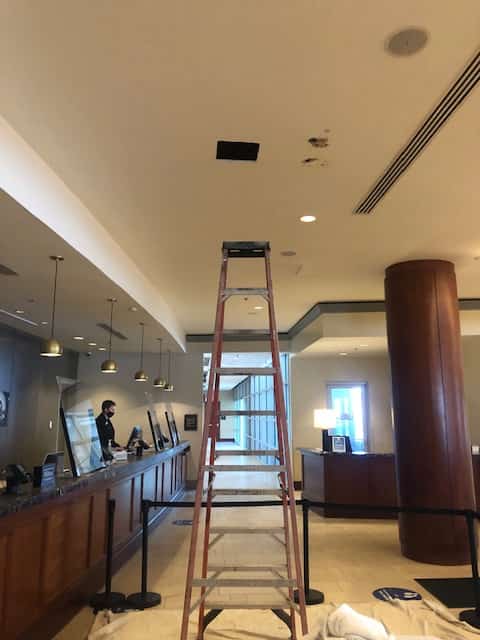Ladder work is a key part of being a commercial painter. Both interior ladder work and exterior ladder work.

We have no shortage of ladders. Step ladders and extension ladders. This is a ten foot step ladder which we used to repair a hole in the ceiling of a Omaha Nebraska Hotel. Then we matched the ceiling paint and painted the area.
The most often used step ladder for us is a six foot. We use from four feet to twelve foot step ladders and sixteen to forty foot extension ladders. We use man lifts and scaffolding as well depending on the job.
We used both scaffolding and a man lift on different projects at this same Omaha Hotel.
We recently used scaffolding to bridge over an escalator so we could reach the ceiling. The scaffolding had to go on the escalator steps and it was not as stable as I would like but we were able to brace it and level the legs with blocking. The big problem was we could not get the up and down escalator to stop with the steps level with each other. It worked.

We used a manlift to reach the ceiling in the Hotel Ballroom. The ceiling was at about 28 feet. The lift made the job much easier and we were able to complete the job before the room needed to be used.

One of the often overlooked aspects to using ladders, scaffolding or a manlift is protecting the area from debris and paint ahead of time. It’s easy to get something set up and then realize you need to protect the floor or surroundings with plastic.
Safety
Safety is important and easily overlooked. There are many websites that have safety information about using scaffolding, ladders, etc. A good one is the American Ladder Institute . The information they have is useful. Common sense goes a long way when using any equipment. Ladders, scaffolding, lifts included. Another site with useful information is the American Society of Safety Professionals . They have some good information but it gets technical and not really easy to read.
The significance of ladder safety
It is critical to use a ladder safely in order to avoid accidents and injuries. Falls from ladders are a primary source of industrial injuries and deaths, according to the Centers for Disease Control and Prevention (CDC). In the United States, an estimated 6,100 ladder-related injuries were handled in emergency departments in 2018.
To use a ladder properly, select the appropriate ladder for the work, set it up correctly, and maintain three points of contact while climbing the ladder. Overreaching or leaning too far to one side should also be avoided, as this might cause the ladder to tip or become unstable. When using a ladder, you can avoid accidents and injuries by following these safety procedures.
The dangers of using a ladder
Falls. Falling is one of the most common hazards of using a ladder. This can occur if the ladder is not correctly set up, if it is not secure or stable, or if the person using the ladder loses their balance. Depending on the height of the fall, falls from ladders can result in serious injuries or even death.
Electrocution. Electrocution can occur if a ladder comes into contact with electrical lines or equipment. This is a significant risk that can result in serious injuries or death. When working near electrical lines or equipment, use a non-conductive ladder to avoid this risk.
Structural failure. A broken or improperly maintained ladder might fail or collapse while in use. This can lead to severe injuries or falls. To avoid this risk, inspect the ladder prior to use and repair or replace any damaged sections.
It is critical to use a ladder safely in order to avoid accidents and injuries. When using a ladder, you can help to prevent accidents and injuries by following safety rules and using common sense. However, it is critical to be aware of the potential hazards of using a ladder and to take precautions to reduce those hazards to ensure your safety and the safety of people around you.
Selecting the best ladder
When it comes to jobs or projects that include the use of a ladder, choosing the correct ladder is critical for assuring your safety and the success of the job. There are various types of ladders available, each suited for specific uses and tasks. This post will go through the many types of ladders and the elements to consider when choosing the correct ladder for the job.
There are several different types of ladders available, each with its own set of applications and tasks.
Some common types of ladders include:
Step ladders. These are intended for tasks that require reaching relatively modest heights, such as changing a light bulb or painting a wall. They have a set of steps to climb and a platform on the top. Step ladders come in a variety of sizes, ranging from short models that are a few feet tall to towering ones that are many feet tall.
Extension ladders. Extension ladders are designed for tasks requiring you to reach higher heights, such as cleaning gutters or reaching a house’s roof. They have two pieces that may be extended or collapsed and are adjustable in length to reach different heights. Extension ladders are commonly built of aluminum or fiberglass and come in a variety of diameters and weight capacities.
Multi-purpose ladders. Also known as combination ladders, are adaptable ladders that can be used as a step ladder, an extension ladder, or a scaffold. They are great for duties that necessitate reaching different heights or working at various angles. Multi-purpose ladders are commonly built of aluminum or fiberglass and come in a variety of sizes and weight capacities.
When choosing a ladder for a specific task or project, there are several factors to consider, including:
The intended application. The type of ladder you require will be determined by the task or project you are working on. A step ladder may be suitable for tasks that require you to reach relatively low heights. An extension ladder may be a better solution for tasks that require you to reach higher heights. A multi-purpose ladder may be the most versatile alternative for duties that demand you to work at different heights or angles.
Height of the task. The size and length of the ladder you require will be based on the height of the job at hand. A short ladder may be suitable for tasks that require you to reach relatively low heights. A longer ladder will be required for jobs that need you to reach higher heights. It is important to choose a ladder that is long enough to reach the required height while not becoming unstable or difficult to manage.
Weight capacity. It is critical to select a ladder with an appropriate weight capacity for your needs. The weight capacity of most ladders is mentioned on the label or in the manufacturer’s specs. Before using the ladder, make sure to verify its weight capacity to ensure that it is appropriate for your needs.
Tips for Choosing the Right Ladder
Consider the surface on which you will be using the ladder. If you want to use the ladder on soft or uneven terrain, a ladder with wide, flat feet or a stabilizer bar may be a better option.
Consider the material used to construct the ladder. Aluminum ladders are lightweight and portable, however they are not as sturdy as fiberglass or wood ladders.
Setting up a ladder
Proper setup and positioning are required for safe and effective ladder use. A ladder that has not been properly set up might be unstable and unsafe to use, resulting in accidents and injuries. In this post, we will go through how to correctly set up a ladder to ensure your safety and the effectiveness of the job.
Positioning the ladder.
The first step in erecting a ladder is to place it on a stable, level surface. This is necessary to guarantee that the ladder is secure and does not wobble or tip over when in use. Avoid putting the ladder on slick or uneven surfaces, as this increases the likelihood of an accident or injury.
If you must use the ladder on an uneven surface, lay bricks or other stable objects under the ladder’s feet to level it out. Before climbing the ladder, make sure it’s stable, and don’t use it if it feels unstable or wobbling.
Extending and securing the ladder.
Before climbing an extension ladder, ensure that it is properly extended and secured. Begin by fully opening and extending the ladder to the appropriate length. Make sure the locks are properly fastened and the ladder is fully extended.
Next, set the ladder at an appropriate angle by positioning the base approximately one-quarter of the distance from the wall or other vertical surface. This will help to guarantee that the ladder remains stable and secure while in use.
Keeping three points of contact.
It is critical to keep three points of contact at all times when climbing a ladder. This means always keeping two hands and one foot, or two feet and one hand, on the ladder. This helps keep you balanced and prevents falls.
Avoid overreaching or leaning too far to one side.
When using a ladder, it is important to avoid overreaching or leaning too far to one side. As a result, the ladder may tip or become unstable, resulting in accidents and injuries. Do not try to stretch or lean to reach a spot that is beyond the reach of the ladder. Instead, descend the ladder and reposition it closer to you.
Setting up a ladder correctly is critical for your safety and the productivity of the job. By following the procedures indicated above, you can help to avoid accidents and injuries while completing your job or project safely and effectively.
Maintaining a ladder
Proper maintenance is required to keep a ladder in good working order while also assuring its effectiveness and safety. You can help to extend the life of your ladder and ensure that it is always available to use when you need it by following a regular maintenance program. This post will go through how to maintain a ladder to ensure its safety and longevity.
Before using a ladder, inspect it
Before using a ladder, make sure it is free of damage or wear. Examine the rungs for bent or broken rungs, loose or missing sections, and other indicators of damage. If you discover any damage to the ladder, do not use it until it has been repaired or replaced.
Repairing or replacing damaged parts
If you discover any damage or wear on your ladder, repair or replace the damaged sections as quickly as possible. This will help in ensuring the ladder’s effectiveness and safety. Tightening or replacing loose rungs, replacing missing or damaged sections, and repairing any other issues that may compromise the stability or safety of the ladder are examples of routine repairs.
Storing the ladder correctly.
Proper storage is essential for maintaining a ladder’s condition and preventing damage. When storing a ladder, pick a dry, well-ventilated position away from direct sunlight or other heat sources. Avoid keeping the ladder in wet or humid environments, since this can cause rust and other sorts of damage.
If you must store the ladder outside, protect it from the weather by covering it with a tarp or other protective cover. Avoid piling heavy objects on top of the ladder, since this can damage or deform it.
Regular Cleaning and Maintenance
Cleaning and maintaining a ladder on a regular basis can assist to extend its life and keep it in good operating order. Simply wipe down a ladder with a moist cloth or mild detergent to eliminate dirt and grime. Harsh chemicals and abrasives should be avoided as they can harm the ladder.
In addition to cleaning the ladder, it is critical to inspect it on a regular basis for wear or damage. Tighten any loose or unsteady rungs, replace any missing or damaged parts, and carry out any other required maintenance to keep the ladder in good working order.
Maintaining a ladder is critical to its effectiveness and safety. You can help to extend the life of your ladder and ensure that it is always available to use when you need it by following a regular maintenance plan and addressing any concerns as soon as they develop.
Hire an expert
If you are considering hiring a professional painter to complete a painting project, we encourage you to do so. There are several benefits to hiring a professional painter, including:
Safety: Using a ladder can be dangerous, especially if you are unfamiliar with it. A professional painter is trained in ladder safety and has the skills and experience to securely and successfully set up and use a ladder. You can eliminate the danger of accidents or injuries associated with ladder use by employing a professional.
Quality: Professional painters are trained and skilled in the skills and processes required to produce a high-quality paint job. They have the knowledge and tools necessary to prepare surfaces, apply paint evenly and smoothly, and achieve a professional-looking finish. You can be confident that by hiring a professional, you will obtain a high-quality paint job that you will be proud of.
Efficiency: A professional painter may finish a painting project faster than a non-professional. They have the necessary skills, equipment, and knowledge to complete the task swiftly and efficiently, saving you time and effort.
Warranty: Many professional painters provide a warranty on their work, which means that if there are any problems with the paint job, they will correct them at no extra charge to you. This gives you piece of mind and ensures that you are happy with the end outcome.
Hiring a professional painter has many advantages, including safety, quality, efficiency, and peace of mind. If you are planning a painting project, we encourage you to hire a professional to ensure the best possible results.

